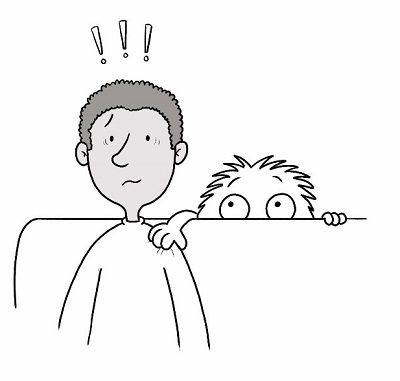A Compassionate Guide to Anxiety During the COVID-19 Pandemic Part 1: Understanding Why We Are so Anxious Right Now
A Compassionate Guide to Anxiety During the COVID-19 Pandemic Part 1: Understanding Why We Are so Anxious Right Now

Life in the time of a pandemic is difficult. Our lives have suddenly and dramatically narrowed while we try to avoid an invisible threat which has been spreading across our planet. And where there is even the whiff of a threat, there is anxiety.
The fact that we are feeling more anxious these days didn’t start with COVID-19. Our anxiety levels were rising well before this virus made itself known. The pandemic, however, has brought to the surface heightened anxiety that for many has been simmering underneath for quite some time.
This anxiety brings with it powerful symptoms such as chronic worry, restlessness, insomnia, feelings of dread, tense muscles, irritability, and a tremendous urge to defeat a threat. It can be exhausting. It can make us hurt. It can even make us feel sad or hopeless. Anxiety can feel like a malevolent force trying to attack our well-being--like it is trying to torture us.
But is our anxiety really out to get us?
Our relationship with our anxiety matters
When anxiety is perceived as an aggressor in our lives, many of us naturally set out to try to defeat the “beast” within. We fight our anxiety—tensing up and cursing its very existence. Through the sheer act of loathing, we try to make it STOP!
Or we try to hide from it.
At the slightest growl of anxiety, we may rush to eat a sweet, have a drink, or retreat to yet another online distraction. However, we must come up for air at some point, and there our anxiety awaits. And the struggle continues.
Then, we might consult one of many thousands of books, blogs, or articles that contain the enticing magic words in their title, “How to Become Anxiety-Free.” Yet, after faithfully following the path laid out for us on the road to vanquishing our anxiety beasts, here we are--feeling anxious once again. “Anxiety-free” is a marketing catch-phrase, not a realistic goal for most humans.
Our anxiety beasts mean well
I am reminded of the classic fairy tale Beauty and the Beast. This is the tale of a seemingly ferocious beast who, upon first glance, looks and sounds like the villain of the story. Halfway through, however, you come to learn that the beast isn’t the villain—he’s the misunderstood hero. Yes, he still looks beastly and has an unpleasant roar, but his heart is in the right place.
Anxiety is like that noisy beast. It can be loud and unpleasant to be around, but it means well. Its job is to protect us from ANYTHING it perceives to be a threat—whether that be public speaking at work or a widespread invisible virus. Anxiety is a well-intentioned, but very glitchy hero.
Anxiety is a flawed
All the great heroes have a weakness. For Supergirl it’s Kryptonite. For anxiety beasts, it’s “context.” It has difficulty understanding that the complexity of the COVID-pandemic is not something that can be defeated by the usual tactics of fighting or fleeing.
But It wants to help. When our anxiety is warning us to stay safe by social distancing and decontaminating per CDC guidelines, it is doing the right thing (trying to serve and protect) at the right time (we are at increased risk right now).
However, our anxiety beasts don’t stop there. They demand one-hundred percent certainty that you (and those close to us) will remain safe. It craves to know with certainty exactly when this pandemic will be over.
Anxiety is an impatient beast. It wants this problem solved right now. It wants a cure for this virus and for life to resume as normal now! In this way, it is still doing the right thing, trying to protect us, but at a time when our ability to vanquish an immediate threat is non-existent. We will be sitting with uncertainty for potentially much longer. Other than following CDC recommendations, there is little that most of us can do right now to speed up the course of this virus. There is not much else to do other than carry on with life in the best way that we can in these unusual circumstances.
Origin of our glitchy anxiety beasts
Our anxiety evolved millions of years ago when our distant ancestors fought daily to survive in a harsh, unforgiving prehistoric world. Dangers were straightforward. They mainly consisted of one very simple law of the land—I need to eat and not get eaten. Life consisted of getting up, leaving the cave, and searching for food. Anxiety knew how to energize our ancestors to run far and fast (or hide) when they bumped into tougher creatures. And it knew how to motivate them to kill and eat creatures weaker than them. Anxiety was quite effective at helping our ancestors face those prehistoric challenges. It worked well. We are still here.
After millions of years of our anxiety being molded to protect us in those specific circumstances, “suddenly” the world changed. There was an industrial revolution (only 250 years ago) that changed human life significantly. In recent decades, the information age and technological marvels have further transformed human life. Smartphone and internet technologies have only been around for a relative blink of an eye in the human timeline. Rather than worrying about the saber-toothed tiger getting ready to pounce, we can now worry about things we see on the news or hear about from our extended social media networks. Anxiety didn’t change, we changed.
Our distant ancestors, after a long day of fighting, fleeing, and gathering resources, would come back to the relative safety of their small tribes and be soothed through compassionate connection. Now, with so many of us stuck at home, rather than resting in the comforting embrace of an extended group of family, friends, and neighbors, our anxiety is further triggered by heartbreaking and scary news programs.
With the COVID-19 pandemic, things have suddenly and dramatically changed overnight. For many of us, our anxiety beasts are howling louder than ever.
Fight the threat! Run and hide from the threat!
While we need to take reasonable safety precautions, no matter what we do right now, we are still left with uncertainty and the possibility of danger. Even though the survival statistics with COVID-19 are in our favor, our anxiety does not want to rest until the risk is zero.
How we inadvertently increase our anxiety---and our suffering
It is not reasonable to expect that we won’t be anxious during these difficult weeks ahead. These are genuinely disturbing times. If we view our anxiety as a personal failure or weakness—or as a tormentor that must be defeated, we begin to see our emotion as a threat. Our anxiety, whose job it is to howl wildly when we are under threat will then treat itself as a threat. We then become anxious about feeling anxious. This added anxiety is often accompanied by a greater sense of suffering.
A More Compassionate Approach to Anxiety
Compassion involves first becoming aware that suffering and then having a desire and commitment to alleviate that suffering. In light of COVID-19, it involves adopting the mindset:
These are anxiety-provoking times--how can I help ease my (and others’) suffering?
Compassion is certainly is not a recipe for feeling good all of the time, but research has shown that increasing compassion is related to a quieting of anxiety and depression and an enhanced sense of well-being. Instead of greeting anxiety as a villain, if we choose to look at it from a more compassionate lens we will likely experience less suffering over the weeks of uncertainty to come.












